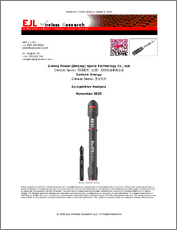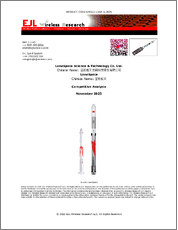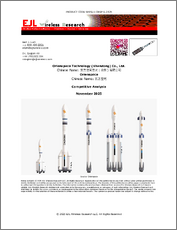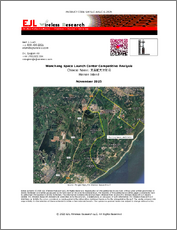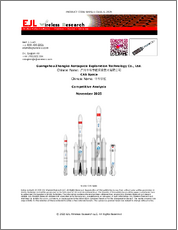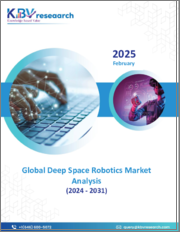
|
시장보고서
상품코드
1675310
세계의 심우주 탐사 및 기술 시장 : 기술별, 서브시스템별, 미션 유형별, 용도별, 최종사용자별, 지역별(2025-2033년)Deep Space Exploration and Technology Market by Technology, Subsystem, Mission Type, Application, End User, and Region 2025-2033 |
||||||
심우주 탐사 및 기술 시장 세계 시장 규모는 2024년 381억 달러에 달했습니다. 향후 IMARC Group은 2033년까지 시장 규모가 583억 달러에 달하고, 2025-2033년 연평균 성장률(CAGR)은 4.82%를 보일 것으로 예측했습니다. 3D 프린팅 및 적층 가공(AM)의 유연성, 우주 탐사 증가, 우주 예산 증가, 각국 정부 기관의 수많은 승인 이 시장을 견인하는 요인 중 일부로 작용하고 있습니다.
심우주 탐사 및 기술이란 지구 대기권을 넘어선 우주의 과학적 연구와 탐사, 특히 태양계 행성, 소행성 및 기타 천체의 연구를 말합니다. 이 분야에서는 우주선, 망원경, 탐사선 등의 첨단 기술을 활용하여 이들 천체를 관측하고 데이터를 수집합니다. 심우주 탐사와 그 기술은 다른 행성이나 천체의 특성과 특징을 연구함으로써 우주와 그 기원, 진화에 대한 이해를 넓히는 데 필수적입니다. 또한 지구와 우주의 형성과 역사에 대한 통찰력을 얻는 데에도 과학자들을 돕습니다. 최근 로봇 탐사기, 고해상도 영상 시스템 등 첨단 기술의 발달로 심우주 탐사 분야에 혁명적인 변화가 일어나고 있으며, 원거리 천체를 보다 세밀하고 정확하게 관측할 수 있게 되었습니다.
심우주 탐사 및 기술 시장 동향 :
시장을 이끄는 주요 요인 중 하나는 민간 및 공공 부문 모두에서 우주 탐사에 대한 지식 수요 증가와 관심 증가입니다. 또한 SpaceX, Blue Origin과 같은 민간 기업과 ESA, NASA와 같은 국가 우주 기관은 과학 연구, 신기술 개발, 우주 관광 및 식민지화 가능성을 모색하기 위해 심우주 탐사 및 기술에 적극적으로 투자하고 있습니다. 또한, 여러 국가의 정부들은 심우주 탐사를 포함한 우주 탐사에 광범위하게 투자하고 있습니다. 이 외에도 태양계 외계 행성 등 새로운 천체의 발견이 시장 성장을 가속하고 있습니다. 또한, 우주 여행에 대한 관심이 높아짐에 따라 여러 기업이 우주 여행을 지원하기 위해 새로운 우주선과 기술을 개발하고 있으며, 그 결과 시장 전망이 밝아지고 있습니다. 또한, 우주 탐사는 여러 국가에서 국가 안보와 국방의 중요한 측면이 되었으며, 이는 전 세계적으로 제품 채택률을 가속화하고 있습니다. 이러한 요인 외에도 인류의 호기심과 탐구심 증가는 우주 탐사의 원동력이 되고 있습니다. 다른 성장 촉진요인으로는 3D 프린팅의 유연성, 적층 가공(AM), 우주 자산에 사용되는 부품의 비용 절감, 생산 시간 단축, 주요 기업 및 정부 기관의 끊임없는 연구개발(R&D) 등이 있습니다.
본 보고서에서 다룬 주요 질문
- 세계 심우주 탐사 및 기술 시장은 지금까지 어떻게 성장해 왔는가?
- 세계 심우주 탐사 및 기술 시장 성장 촉진요인, 억제요인, 기회는 무엇인가?
- 각 촉진요인, 억제요인, 기회가 세계 심우주 탐사 및 기술 시장에 미치는 영향은?
- 주요 지역 시장은?
- 가장 매력적인 심우주 탐사 및 기술 시장은 어느 국가인가?
- 기술별 시장 분석은?
- 심우주 탐사 및 기술 시장에서 가장 매력적인 기술은 무엇인가?
- 서브시스템별 시장 현황은?
- 심우주 탐사 및 기술 시장에서 가장 매력적인 서브시스템은?
- 미션 유형별 시장 분석은?
- 심우주 탐사 및 기술 시장에서 가장 매력적인 미션 유형은?
- 용도별 시장 분석은?
- 심우주 탐사 및 기술 시장에서 가장 매력적인 용도는?
- 최종사용자별 시장 분석은?
- 심우주 탐사 및 기술 시장에서 가장 매력적인 최종 사용자는?
- 세계 심우주 탐사 및 기술 시장 경쟁 구도는?
- 세계 심우주 탐사 및 기술 시장의 주요 기업은?
목차
제1장 서문
제2장 조사 범위와 조사 방법
- 조사 목적
- 이해관계자
- 데이터 소스
- 1차 정보
- 2차 정보
- 시장 추정
- 보텀업 접근
- 톱다운 접근
- 조사 방법
제3장 주요 요약
제4장 서론
- 개요
- 주요 업계 동향
제5장 세계의 심우주 탐사 및 기술 시장
- 시장 개요
- 시장 실적
- COVID-19의 영향
- 시장 예측
제6장 시장 분석 : 기술별
- 로켓
- 랜더
- 로봇
- 위성
- 인공위성
제7장 시장 분석 : 서브시스템별
- 추진 시스템
- 주요 부문
- 화학
- 비화학
- 주요 부문
- 내비게이션 및 유도 시스템
- 지휘 통제 시스템
- 기타
제8장 시장 분석 : 미션 유형별
- 유인 미션
- 무인 미션
제9장 시장 분석 : 용도별
- 달 탐사
- 운송
- 궤도 인프라
- 화성 탐사
- 기타
제10장 시장 분석 : 최종사용자별
- 정부 우주기관
- 상업
- 군
제11장 시장 분석 : 지역별
- 북미
- 미국
- 캐나다
- 아시아태평양
- 중국
- 일본
- 인도
- 한국
- 호주
- 인도네시아
- 기타
- 유럽
- 독일
- 프랑스
- 영국
- 이탈리아
- 스페인
- 러시아
- 기타
- 라틴아메리카
- 브라질
- 멕시코
- 기타
- 중동 및 아프리카
- 시장 분석 : 국가별
제12장 성장 촉진요인 및 억제요인, 기회
- 개요
- 성장 촉진요인
- 성장 억제요인
- 기회
제13장 밸류체인 분석
제14장 Porter의 Five Forces 분석
- 개요
- 바이어의 교섭력
- 공급 기업의 교섭력
- 경쟁 정도
- 신규 진출업체의 위협
- 대체품의 위협
제15장 가격 분석
제16장 경쟁 구도
- 시장 구조
- 주요 기업
- 주요 기업 개요
- Airbus SE
- Lockheed Martin Corporation
- Maxar Technologies Inc.
- Northrop Grumman Corporation
- Space Exploration Technologies Corp.(SpaceX)
- Thales Group
- The Boeing Company
The global deep space exploration and technology market size reached USD 38.1 Billion in 2024. Looking forward, IMARC Group expects the market to reach USD 58.3 Billion by 2033, exhibiting a growth rate (CAGR) of 4.82% during 2025-2033. The flexibility of 3D printing and additive manufacturing (AM), rising number of space expeditions, increasing space budgets and numerous approvals by government agencies of various nations represent some of the factors driving the market.
Deep space exploration and technology refer to the scientific study and exploration of space beyond the Earth's atmosphere, especially the study of planets, asteroids, and other celestial bodies in solar system. This field involves the use of advanced technologies, such as spacecraft, telescopes, and probes, to observe and gather data on these celestial bodies. Deep space exploration and technology are essential for expanding the understanding of the universe, its origins, and evolution by studying the properties and characteristics of other planets and celestial bodies. It also helps scientists in gaining insights into the formation and history of Earth and the universe. In recent years, the development of advanced technologies, such as robotic spacecraft and high-resolution imaging systems, has revolutionized the field of deep space exploration, allowing more detailed and accurate observations of distant celestial bodies.
Deep Space Exploration and Technology Market Trends:
One of the primary factors driving the market is the increasing demand for knowledge and growing interest in space exploration from both private and public sectors. In addition, Additionally, private organizations, such as SpaceX and Blue Origin, along with national space agencies, such as ESA and NASA, are extensively investing in deep space exploration and technology to perform scientific research, develop new technologies, and explore the potential for space tourism and colonization. Moreover, governments of various nations are extensively investing in space exploration, including deep space missions. Other than this, the discovery of new celestial bodies, such as exoplanets, is propelling the market growth. Furthermore, with the growing interest in space tourism, several companies are developing new spacecraft and technologies to support space tourism, consequently providing a positive market outlook. Furthermore, the exploration of space has become an essential aspect of national security and defense for various nations, which has accelerated the product adoption rate across the globe. Apart from these factors, the increasing human curiosity and exploration is a driving force behind space exploration. Other growth-inducing factors include flexibility of 3D printing, additive manufacturing (AM), cost weight reductions of components used in space assets, less production time, and constant research and development activities (R&D) in this field by key players and government organizations.
Key Market Segmentation:
Technology Insights:
- Rockets
- Landers
- Robots
- Satellites
- Orbiters
Subsystem Insights:
- Propulsion system
- Chemical
- Non-chemical
- Navigation and guidance system
- Command and control system
- Others
Mission Type Insights:
- Manned Mission
- Unmanned Mission
Application Insights:
- Moon Exploration
- Transportation
- Orbital Infrastructure
- Mars Exploration
- Others
End User Insights:
- Government Space Agencies
- Commercial
- Military
Regional Insights:
- North America
- United States
- Canada
- Asia-Pacific
- China
- Japan
- India
- South Korea
- Australia
- Indonesia
- Others
- Europe
- Germany
- France
- United Kingdom
- Italy
- Spain
- Russia
- Others
- Latin America
- Brazil
- Mexico
- Others
- Middle East and Africa
- The report has also provided a comprehensive analysis of all the major regional markets that include North America (the United States and Canada), Asia-Pacific (China, Japan, India, South Korea, Australia, Indonesia, and others), Europe (Germany, France, the United Kingdom, Italy, Spain, Russia, and others), Latin America (Brazil, Mexico, and others), and the Middle East and Africa. According to the report, North America was the largest market for deep space exploration and technology. Some of the factors driving the North America deep space exploration and technology market included the growing interest in space tourism, US government allocating significant funds towards space exploration missions, development of new technologies, such as artificial intelligence and robotics, etc.
Competitive Landscape:
- The report has also provided a comprehensive analysis of the competitive landscape in the deep space exploration and technology market. Competitive analysis such as market structure, market share by key players, player positioning, top winning strategies, competitive dashboard, and company evaluation quadrant has been covered in the report. Also, detailed profiles of all major companies have been provided. Some of the companies covered include Airbus SE, Lockheed Martin Corporation, Maxar Technologies Inc., Northrop Gruman Corporation, Space Exploration Technologies Corp. (SpaceX), Thales Group, and The Boeing Company.
Key Questions Answered in This Report:
- How has the global deep space exploration and technology market performed so far, and how will it perform in the coming years?
- What are the drivers, restraints, and opportunities in the global deep space exploration and technology market?
- What is the impact of each driver, restraint, and opportunity on the global deep space exploration and technology market?
- What are the key regional markets?
- Which countries represent the most attractive deep space exploration and technology market?
- What is the breakup of the market based on technology?
- Which is the most attractive technology in the deep space exploration and technology market?
- What is the breakup of the market based on the subsystem?
- Which is the most attractive subsystem in the deep space exploration and technology market?
- What is the breakup of the market based on mission type?
- Which is the most attractive mission type in the deep space exploration and technology market?
- What is the breakup of the market based on the application?
- What is the most attractive application in the deep space exploration and technology market?
- What is the breakup of the market based on the end user?
- What is the most attractive end user in the deep space exploration and technology market?
- What is the competitive structure of the global deep space exploration and technology market?
- Who are the key players/companies in the global deep space exploration and technology market?
Table of Contents
1 Preface
2 Scope and Methodology
- 2.1 Objectives of the Study
- 2.2 Stakeholders
- 2.3 Data Sources
- 2.3.1 Primary Sources
- 2.3.2 Secondary Sources
- 2.4 Market Estimation
- 2.4.1 Bottom-Up Approach
- 2.4.2 Top-Down Approach
- 2.5 Forecasting Methodology
3 Executive Summary
4 Introduction
- 4.1 Overview
- 4.2 Key Industry Trends
5 Global Deep Space Exploration and Technology Market
- 5.1 Market Overview
- 5.2 Market Performance
- 5.3 Impact of COVID-19
- 5.4 Market Forecast
6 Market Breakup by Technology
- 6.1 Rockets
- 6.1.1 Market Trends
- 6.1.2 Market Forecast
- 6.2 Landers
- 6.2.1 Market Trends
- 6.2.2 Market Forecast
- 6.3 Robots
- 6.3.1 Market Trends
- 6.3.2 Market Forecast
- 6.4 Satellites
- 6.4.1 Market Trends
- 6.4.2 Market Forecast
- 6.5 Orbiters
- 6.5.1 Market Trends
- 6.5.2 Market Forecast
7 Market Breakup by Subsystem
- 7.1 Propulsion System
- 7.1.1 Market Trends
- 7.1.2 Key Segments
- 7.1.2.1 Chemical
- 7.1.2.2 Non-Chemical
- 7.1.2 Market Forecast
- 7.2 Navigation and Guidance System
- 7.2.1 Market Trends
- 7.2.2 Market Forecast
- 7.3 Command and Control System
- 7.3.1 Market Trends
- 7.3.2 Market Forecast
- 7.4 Others
- 7.4.1 Market Trends
- 7.4.2 Market Forecast
8 Market Breakup by Mission Type
- 8.1 Manned Mission
- 8.1.1 Market Trends
- 8.1.2 Market Forecast
- 8.2 Unmanned Mission
- 8.2.1 Market Trends
- 8.2.2 Market Forecast
9 Market Breakup by Application
- 9.1 Moon Exploration
- 9.1.1 Market Trends
- 9.1.2 Market Forecast
- 9.2 Transportation
- 9.2.1 Market Trends
- 9.2.2 Market Forecast
- 9.3 Orbital Infrastructure
- 9.3.1 Market Trends
- 9.3.2 Market Forecast
- 9.4 Mars Exploration
- 9.4.1 Market Trends
- 9.4.2 Market Forecast
- 9.5 Others
- 9.5.1 Market Trends
- 9.5.2 Market Forecast
10 Market Breakup by End User
- 10.1 Government Space Agencies
- 10.1.1 Market Trends
- 10.1.2 Market Forecast
- 10.2 Commercial
- 10.2.1 Market Trends
- 10.2.2 Market Forecast
- 10.3 Military
- 10.3.1 Market Trends
- 10.3.2 Market Forecast
11 Market Breakup by Region
- 11.1 North America
- 11.1.1 United States
- 11.1.1.1 Market Trends
- 11.1.1.2 Market Forecast
- 11.1.2 Canada
- 11.1.2.1 Market Trends
- 11.1.2.2 Market Forecast
- 11.1.1 United States
- 11.2 Asia-Pacific
- 11.2.1 China
- 11.2.1.1 Market Trends
- 11.2.1.2 Market Forecast
- 11.2.2 Japan
- 11.2.2.1 Market Trends
- 11.2.2.2 Market Forecast
- 11.2.3 India
- 11.2.3.1 Market Trends
- 11.2.3.2 Market Forecast
- 11.2.4 South Korea
- 11.2.4.1 Market Trends
- 11.2.4.2 Market Forecast
- 11.2.5 Australia
- 11.2.5.1 Market Trends
- 11.2.5.2 Market Forecast
- 11.2.6 Indonesia
- 11.2.6.1 Market Trends
- 11.2.6.2 Market Forecast
- 11.2.7 Others
- 11.2.7.1 Market Trends
- 11.2.7.2 Market Forecast
- 11.2.1 China
- 11.3 Europe
- 11.3.1 Germany
- 11.3.1.1 Market Trends
- 11.3.1.2 Market Forecast
- 11.3.2 France
- 11.3.2.1 Market Trends
- 11.3.2.2 Market Forecast
- 11.3.3 United Kingdom
- 11.3.3.1 Market Trends
- 11.3.3.2 Market Forecast
- 11.3.4 Italy
- 11.3.4.1 Market Trends
- 11.3.4.2 Market Forecast
- 11.3.5 Spain
- 11.3.5.1 Market Trends
- 11.3.5.2 Market Forecast
- 11.3.6 Russia
- 11.3.6.1 Market Trends
- 11.3.6.2 Market Forecast
- 11.3.7 Others
- 11.3.7.1 Market Trends
- 11.3.7.2 Market Forecast
- 11.3.1 Germany
- 11.4 Latin America
- 11.4.1 Brazil
- 11.4.1.1 Market Trends
- 11.4.1.2 Market Forecast
- 11.4.2 Mexico
- 11.4.2.1 Market Trends
- 11.4.2.2 Market Forecast
- 11.4.3 Others
- 11.4.3.1 Market Trends
- 11.4.3.2 Market Forecast
- 11.4.1 Brazil
- 11.5 Middle East and Africa
- 11.5.1 Market Trends
- 11.5.2 Market Breakup by Country
- 11.5.3 Market Forecast
12 Drivers, Restraints, and Opportunities
- 12.1 Overview
- 12.2 Drivers
- 12.3 Restraints
- 12.4 Opportunities
13 Value Chain Analysis
14 Porters Five Forces Analysis
- 14.1 Overview
- 14.2 Bargaining Power of Buyers
- 14.3 Bargaining Power of Suppliers
- 14.4 Degree of Competition
- 14.5 Threat of New Entrants
- 14.6 Threat of Substitutes
15 Price Analysis
16 Competitive Landscape
- 16.1 Market Structure
- 16.2 Key Players
- 16.3 Profiles of Key Players
- 16.3.1 Airbus SE
- 16.3.1.1 Company Overview
- 16.3.1.2 Product Portfolio
- 16.3.1.3 Financials
- 16.3.1.4 SWOT Analysis
- 16.3.2 Lockheed Martin Corporation
- 16.3.2.1 Company Overview
- 16.3.2.2 Product Portfolio
- 16.3.2.3 Financials
- 16.3.2.4 SWOT Analysis
- 16.3.3 Maxar Technologies Inc.
- 16.3.3.1 Company Overview
- 16.3.3.2 Product Portfolio
- 16.3.3.3 Financials
- 16.3.4 Northrop Grumman Corporation
- 16.3.4.1 Company Overview
- 16.3.4.2 Product Portfolio
- 16.3.4.3 Financials
- 16.3.4.4 SWOT Analysis
- 16.3.5 Space Exploration Technologies Corp. (SpaceX)
- 16.3.5.1 Company Overview
- 16.3.5.2 Product Portfolio
- 16.3.6 Thales Group
- 16.3.6.1 Company Overview
- 16.3.6.2 Product Portfolio
- 16.3.6.3 Financials
- 16.3.6.4 SWOT Analysis
- 16.3.7 The Boeing Company
- 16.3.7.1 Company Overview
- 16.3.7.2 Product Portfolio
- 16.3.7.3 Financials
- 16.3.7.4 SWOT Analysis
- 16.3.1 Airbus SE
Kindly note that this only represents a partial list of companies, and the complete list has been provided in the report.




